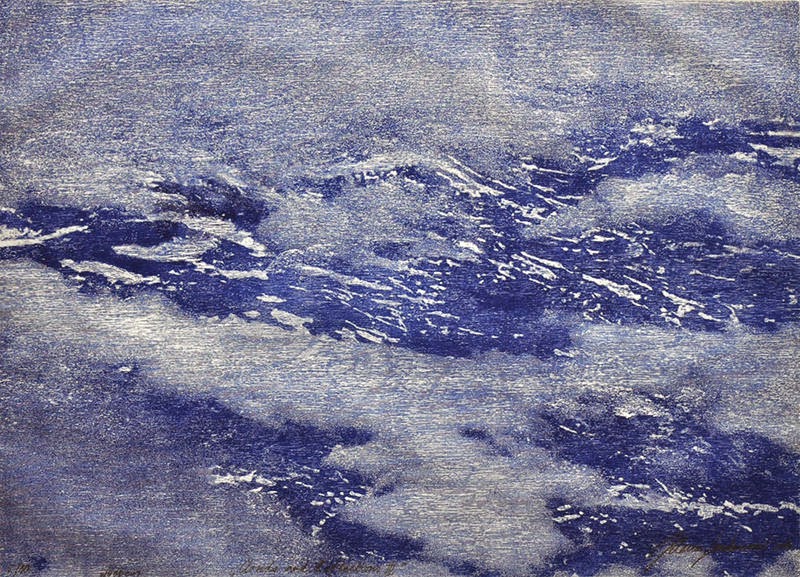 This week I checked out The Print Center's exhibit featuring renowned artists who have recently created works at Durham Press. The exhibition description reads:
This week I checked out The Print Center's exhibit featuring renowned artists who have recently created works at Durham Press. The exhibition description reads:...they have built a reputation for producing complex and often large-scale screenprints, woodcuts and mixed media projects.
Indeed, that is exactly what I found. In this post I feature works by three of the artists, each of whom incorporated the element of woodcut into these large, complex images, and in a similar way. Specifically, they each used printed wood grain to add texture.
The first image here is by Chitra Ganesh. You can view this and more works by her at Durham Press here, and her professional website here. The title is Architects of the Future - City Inside Her. To me, this image and others in the series definitely had a futuristic feel. The woman's floating head and strange sort of goggles with cords that wind back to both an upsidedown city in the sky and ancient structure cause me to imagine that she is plugged into some kind of virtual reality. The use of the wood block is, of course, to create the texture in the sky, red and swirling, reminiscent of either sunset or sunrise, either of which allude to changes, endings and beginnings. Seeing such an obvious example of the low-tech wood block juxtaposed with an image of unfamiliar technology, I cannot help but think, too, of the German Expressionist Blue Riders, whose intent was to make works firmly connected to both the past and the future.

Next up is a work by Mickalene Thomas. You can view this and other works she made at Durham Press here, and her professional website here. The title is Deux Femmes Noires. As it says, two black women are the subject, naked, sleeping, and comfortably entwined. I imagine that the collaged environment where they have been placed describes more of a psychological state than any literal surroundings. The bits and pieces illustrate grass, trees, and other plants, sky, perhaps also some water. Again, wood block printing is used to add the texture of the grain to an entire symphony of patterns, textures, and layers. Bits of cloth from the original photo remain, though here it suggests that the couple lies on a blanket which has been spread out in an open and natural setting. The pieces are mismatched, cut apart, separated by peach-colored lines, suggesting rapid movement, the passage of time, flicks of faulty memory. Despite the surrounding chaos and limited perception, this clearing seems a peaceful oasis.

This third and final image I wanted to feature is by Beatriz Milhazes. You can view this and other works she made at Durham Press here. I found no professional website, but here is the Wikipedia entry on this artist. This print is called Snake Dreaming. I feel the variety of textures in the fields of wood grain run parallel to the asymmetry of the colorful form in the center. Where I saw flower pedals, I now see slithering ribbons, and hear the vibrations of strings. The whole image is so deceptively balanced and prettily designed, it would be easy to miss the mystery. The longer I look, the more I feel I am being drawn into a portal to the unknown.













.png)





